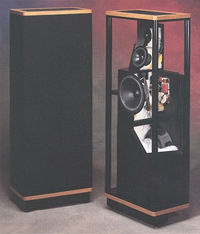| Columns Retired Columns & Blogs |
Vandersteen 2C loudspeaker
Whenever I think of cone speaker systems, I think of three brand names: Snell, Thiel, and Vandersteen. There are many good loudspeakers and many good designers and manufacturers, but it is these three who, in my opinion, consistently produce the best cone loudspeaker systems. All three companies produce full-range systems, transparent systems, and systems which mate well with a wide range of equipment. Their systems can be owned and enjoyed for years. Long after some fad or special feature has given a competing designer brief notoriety, these are the products you turn back to for music.
 The Vandersteen 2C is a case in point. Unquestionably one of the best speaker systems around, it is, at $1200 (with stands), highly affordable by today's standards. It also has remarkable accuracy and overall balance. Many complex systems costing over $5000 are much more dramatic in given ways, but the Vandersteen 2C will, over extended periods of listening, provide all the information from a wide range of music in a balanced and natural form.
The Vandersteen 2C is a case in point. Unquestionably one of the best speaker systems around, it is, at $1200 (with stands), highly affordable by today's standards. It also has remarkable accuracy and overall balance. Many complex systems costing over $5000 are much more dramatic in given ways, but the Vandersteen 2C will, over extended periods of listening, provide all the information from a wide range of music in a balanced and natural form.
The 2C's technical features are provided in the specifications, but several points deserve special note:
The 2C does a better job of providing true deep bass than any other speaker I've encountered close to its price range. The 2C has the ability to produce a true 30Hz at low to moderate volumes with excellent control, whereas most speakers in this price range either give up well above 35Hz or end up with considerable boom.
The crossover is extremely smooth across the band. Many speakers claim to have advanced technology and components but still reveal at least minor problems. The Vandersteen 2C rivals electrostatics in its seamlessness and integration.
The speaker's radiation pattern is extremely well chosen. Imaging is excellent over a relatively wide listening area, but room interaction remains limited. There are no major shifts in imaging and soundstage as frequency rises—a chronic weakness in virtually all speaker designs.
Power handling is greatly improved over earlier models. This is not a "rock speaker" in the sense (or lack of it) that you can drive your ear drums far into your skull. Neither can you push the bass output to the level of a speaker three or four times its size; for that sort of game, you'll need the higher priced Vandersteen or a subwoofer. It will, however, handle orchestral peaks, loud jazz, and rock exceptionally well.
The Vandersteen 2C has a very flat impedance curve for so sophisticated a design. It should be an easy speaker to drive; it could even (Heaven forbid!) be used with your receiver as you claw your way up after the latest visit to bankruptcy court. In a world where more and more speaker manufacturers assume it is their God-given right to make you buy a new amplifier suited to their particular speaker, Richard Vandersteen seems to be willing to sell speakers that allow you to keep the rest of your system.
The Vandersteen is visually inconspicuous, and its stands raise it to just the right height for good listening without having to worry about most minor furniture interference effects. "Livability" is not a common characteristic in high-end loudspeakers—the 2C is a real exception.
The 2C is intended for biwiring, but can also be easily used with only a single speaker cable. Biwiring, however, is clearly beneficial: the bass is more dynamic and controlled, and crossover performance seems smoother. Even non-tweakers will notice the clearer treble and midrange, particularly at low levels or in complex passages, and dynamic transients also improve. I was particularly impressed with the Livewire BC-6 cables supplied for testing this aspect of the Vandersteen's performance—they almost seemed tailored to the speaker, and provided exceptionally well-integrated and musically convincing sound—although the same benefits emerge with Kimber, Monster, and Straight Wire.
The Vandersteen is the product of both considerable design expertise and considerable evolution. Vandersteen, one of the most respected speaker designers in the US, introduced his model 2 in 1977. One of the first speakers to minimize baffle area, pay careful attention to driver alignment, and use first-order crossovers, it has since benefited from extensive use of the Gen-Rad 2512 Fast Fourier Transform analyzer and the Heyser Time Delay Spectrometry system. The Vandersteen 2 started out with all the bells and whistles of its time; the 2C has been refined over six years by an outstanding designer who is also an excellent listener.
The result is an extraordinarily revealing speaker. It will show the effect of small system adjustments, but does not exaggerate their effect. It is a good speaker, for example, through which to listen to differences in wires and VTA/SRA. It is very revealing of the differences between a DC and an AC input on an amplifier like the PS Audio 200C. You can clearly hear the Audio Research SP-11 and D-250 II warm up. While such reviewer quirks may not interest you, they rarely emerge with such clarity in other cone speakers. In fact, the Vandersteen 2C will give the Quad ESL-63 one hell of a good run for its money in terms of resolution and transparency.
- Log in or register to post comments




































